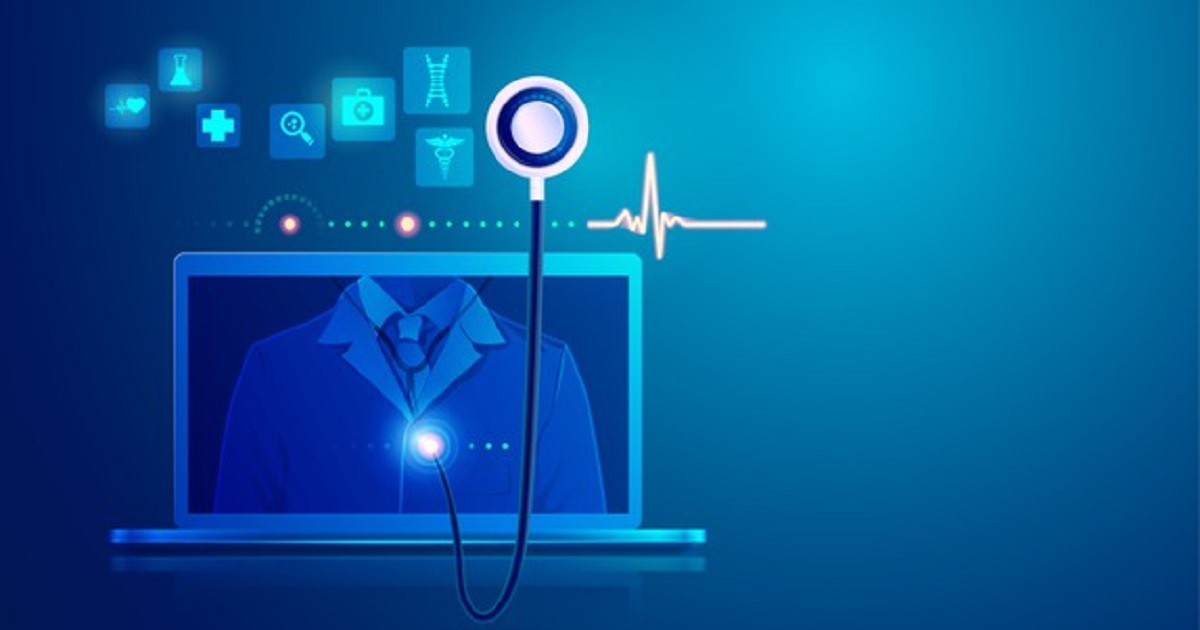
Health Technology, Digital Healthcare
Article | September 7, 2023
The one clear consensus that has emerged from this doubt and anxiety-filled time is that our society will be forever changed by COVID-19. In the recent days, we have seen a general movement toward telecommuting and digital solutions to accommodate the drastic changes caused by this global pandemic. The healthcare industry, which is arguably impacted the most, is no exception to this trend. But while the movement to digital healthcare started well before the outbreak, it has been a slow journey, fraught with many regulations that have slowed its market penetration.
With the current system so overwhelmed, a transition from the face-to-face model of care to a digital model has become vitally necessary, forcing it to happen sooner rather than later. Places that have already embraced the digitalization of healthcare practices have demonstrated the benefits of updating the old-fashioned model. A digital approach to healthcare can have unlimited applications, from telemedicine to a digital system for tracking available hospital beds. All of these applications not only save time but also potentially peoples’ lives by eliminating unnecessary contact between infected and healthy patients as well as their caregivers.
Read More

Healthtech Security
Article | August 31, 2023
The healthcare industry is witnessing an unparalleled phase of expansion and vitality. It is a phase of radical revolution due to the wake of digital transformation. Digital transformation has opened up enormous unique opportunities that were unimaginable until a few years back.
These digital trends are bringing companies and individuals together. Data is the starting point of the digital revolution. These data are then transformed into relationships. Today, including healthcare companies, the success of every company is at stake. In other words, it is how you communicate with customers that matters.
This blog is all about healthcare digital communication, especially healthcare video marketing.
We’ll start by looking at data that demonstrates the power and effectiveness of the video marketing medium. There is nothing equal to the power and efficacy of video marketing in our world today. Then, we’ll look at the video marketing best strategies, healthcare video marketing best practices, and successful examples for healthcare video marketing.
There’s Nothing More Effective than Video Marketing
Here are some numbers that alone demonstrate why video is the most effective marketing medium in the digital age:
More than 5 billion videos are viewed on Youtube every day;
78% of online users watch at least one video every week. And 55% watch one every day;
According to estimates by Cisco, by 2022, 82% of all internet traffic will be generated by video. This percentage was already 72.3% in 2017;
When it comes to video, 55% of people pay more attention than any other type of content;
when viewing a video, the average user retains 95% of the message it contains; this percentage goes down to 10% when we talk about the text;
about 100 million hours of video watched every day on Facebook;
82% of registered Twitter users consume video content constantly;
on Instagram, posts containing video record 38% higher engagement on average than posts containing images;
54% of consumers say they want to see more videos from the brands they follow and support.
Such statistics are compelling for brands, and brands are taking notice. As a result, brands are moving to implement videos as much as possible in their marketing strategies, with excellent results. Two statistics below offer additional proof:
87% of marketing professionals use video in their strategy.
88% of marketers are satisfied with the ROI generated by video marketing campaigns.
This collection of data proves one thing: video is the most effective tool for healthcare digital marketing. And this also applies to the Healthcare sector. It’s even more accurate for this sector, which is intimately involved with consumers as part of their daily lives. Thus, healthcare video marketing is much effective and should be included in your healthcare marketing plan.
Strategies and Best Practices of Healthcare Video Marketing
So, let’s take a closer look at how we can build a video marketing strategy in the Healthcare sector, the fundamental points that must be included, the best practices, and some examples of success.
Start from education
It is often said that we live in the information age. Today, as never before, we have access to all the information we could need in just a few seconds, maybe with just a few taps on our smartphone during a coffee break. Health information is undoubtedly among the most sought-after online. In Italy alone, web searches made on this topic are 4 billion per year, a constantly growing trend.
The downside of all of this is the difficulty of finding your way around this mass of information, which is sometimes complex, misleading, or even untrue. That is why the first task of a company in the Healthcare sector is education. Education is not just a responsibility; and it’s also an opportunity.
In this sense, healthcare videos marketing prove to be the best ally. Healthcare video marketing is a way to provide the consumer with an effortless way to have access to transparent, precise, and authoritative information from your brand. That can be the first step toward establishing a relationship of trust with your brand.
Be clear, but also calm
In this case, let’s start immediately with an exciting and practical example. Targeted toward their younger patients, Miami Children’s Hospital created a healthcare video marketing campaign that explains what happens before, during, and after heart surgery. Understandably, this is a sensitive topic. With this effort of healthcare video marketing, the Miami Children’s Hospital manages to achieve the complex objective of providing clear and authoritative information while at the same time reassuring the viewer.
How?
They make the healthcare video marketing campaign compelling, authoritative, and reassuring by showing the faces of its staff members, demonstrating their professionalism, the environment, the healthcare technologies used, and everything related to the surgery. In this way, the high level of preparation and humanity of the people involved stand out to the viewer.
Learn to be engaging
As we saw above, you have to know how to correctly inform and educate your audience using influential healthcare video marketing trends, all with a calm demeanor. However, it’s also true that success also depends on your ability to excite and involve the viewer for healthcare video marketing in the sector. In short, the keyword is ‘storytelling.
An excellent example is the healthcare video marketing campaign carried out by the dental health department of Bupa UK and addressed to children (but applicable and reachable to adults as well). Through a great use of animations and storytelling, the brand uses the well-known story of the tooth fairy and associates it with childhood memories. This healthcare video marketing campaign has proven to be an excellent vehicle for establishing a truly intimate relationship with the viewer (and, not surprisingly, the video has exceeded 1.3 million views on YouTube).
Another effective way to be direct and engaging is to use influencers in your healthcare video marketing campaigns. An exciting example is the Australian pole vaulter, Amanda Bisk, diagnosed with chronic fatigue syndrome. On her Instagram channel, Bisk talks about her path to fight the disease through fitness, and she has quickly become one of the most famous figures in Healthcare on the platform.
It’s important to note that today, more and more brands target top influencers and micro-influencers. Micro-influencers have a much smaller yet targeted and loyal following of fans. Therefore, their healthcare video marketing messages are perceived by the public as more authentic and personal.
Personalization
94% of marketers believe that personalization is crucial for the future of the business in which it moves. But what do we mean when we talk about personalization?
First of all, it’s not something new: knowing your audience has always been the best way to make a profit, calibrate your communication and your “tone of voice,” and increase engagement and loyalty. But what is the turning point of personalization today?
It is a digital turning point. Today, we all leave traces online at every moment: geolocation, Google searches, preferences on social networks, apps (which in Healthcare are increasingly widespread), and so on. We are talking about a vast amount of data that benefits both companies and consumers from a win-win perspective.
Therefore, it’s a matter of utilizing efficient systems to collect this data, dynamic systems designed with an omnichannel approach in mind. From the collection, the next step is to analyze and interpret this information. Then, you will want to divide your audience into many micro-targets with homogeneous and consistent characteristics to target with tailored communications and offers.
In conclusion, these facts are all the more true in a sector like healthcare that impacts people’s daily lives. The best healthcare video marketing strategy for brands can only be to get closer and closer to customers. That is precisely where specialized companies like us, Media7, come into play. Through compelling B2B healthcare video marketing efforts, we create opportunities for interaction and the possibility to insert custom calls to action.
FREQUENTLY ASKED QUESTIONS
What is a video marketing strategy?
Video marketing strategy is creating, curating, and utilizing videos for marketing products and services of companies to the targeted audience. Marketing teams design the strategy. The idea behind the strategy is to keep the audience engaged with the brand.
Are videos effective for health tech marketing?
Videos are much effective for health tech marketing as people prefer to watch things than reading. Also, people are likely to trust what they see than reading. Videos are the highly impactful medium of marketing for any domain of business, including healthcare.
How to start with healthcare video marketing?
The first step to healthcare video marketing is to define your video marketing strategy. Fix and analyze the target audience to understand the online behavior trends to get an idea about their video engagements and clicks on various social media channels.
Read More

Healthtech Security
Article | November 29, 2023
COVID-19 has sped up the adoption of healthcare technology solutions by healthcare providers. This has unexpectedly brought a peak in opportunity for health tech companies to achieve important business, demonstrating your innovations. However, it is very challenging and competitive as bigger health tech companies pivot and new health tech start-ups keep coming into the healthcare market. This also makes the healthcare technology market an increasingly competitive space.
Thus, all health tech companies need to depend more on effective health tech messaging for their business purpose and credibility. This will help them bring their targeted clients on board for the long-term.
Health tech Messaging Challenges Faced by Marketers
Nowadays, the process of marketing products online is a combat sport. With every passing year, it is becoming more challenging for health tech marketers to beat the algorithms, build the audience, and ultimately win the hearts of the customers through effective health tech messaging.
Digital health leaders are coming up with amazing technology innovations that can revolutionize the healthcare industry. Electronic medical records (EMR) software, medical billing software, medical practice management software, electronic claims software, medical database software, medical research software, medical diagnosis software, medical imaging software, telemedicine software, etc. are some of the examples of amazing technology innovations and latest healthcare technologies. But, things fall apart when it comes to marketing through effective health tech messaging. The following are some of the health tech messaging challenges faced by marketers.
• Communicating the purpose and value of your business and the products effectively to
clients
• Making the clients understand the credibility of the technology products and your business
• Product positioning
• Lack of clear healthcare marketing strategy
• Bad marketing advice
• Lack of effective and compelling marketing content
• Failing to understand the client/buyer persona
• Failing to understand the brand pillars,
• Ignorant of effective use of various messaging channels, and much more
Why Does Effective Health Tech Messaging Matter?
From the introduction part, you might have already understood the power of a good health tech messaging strategy. If you do not have a unified marketing strategy, you will end up merely alienating potential customers; they may end up in confusion about the purpose of your health tech brand. Moreover, without an effective health tech messaging strategy, you may become incoherent to your audience. But the real impact of a cohesive and good health tech messaging strategy will surely go beyond everything we have talked about already and empower your business in all aspects.
Different marketing materials, whether they are social media posts, emails, podcasts, videos, or something else, your health tech messaging strategy will guide you in determining what to focus on and what tone to be used. If you are planning a social media campaign or writing blogs and articles, you will know the attention-grabbing ways of speaking to your customers. This is possible only if you have a defined messaging strategy. Customer service teamwork also becomes more effective and easier, when you have a good health tech messaging strategy. Educating the customer is easier when you speak to them in a tone and language that you know they will understand. Doing it consistently makes you win the customer.
How Health Tech Messaging Can Work for Reaching Healthcare Decision Makers
It is not an easy task to engage healthcare decision-makers in hospitals, insurance providers, health systems, and private practices. These high-powered directors, managers, and executives are busier than ever. This makes the process of health tech marketing difficult. Apart from overwhelming job responsibilities, these healthcare professionals are also inundated with ads, emails, and phone calls. So rather than sending them messages randomly, it is important to help your prospects when they are free from their daily disruptions and have time.
Here, an effective health tech messaging strategy can help you reach out to decision makers easily. Health tech messaging strategy lays out various health tech marketing techniques, tricks, or tactics. These health tech messaging techniques or methodologies are helpful in the three stages of your health tech client journey: awareness, consideration, and decision making stages. Through all these stages of health tech massaging, you help or influence health tech decision makers to recognise they have a problem, consider a solution, and finally they take the decision to purchase your product.
4 Factors Influencing the Effectiveness of Health Tech Messaging
Performing your brand messaging haphazardly is not going to take you anywhere in reaching out to people, who need your products. Instead, you should slow down yourself a bit and build a compelling health tech messaging strategy. Test it, launch it, and learn from it.
If you are strategic, you are truly going to drive your mission despite the noise that is existing on the internet today. Here are four important factors that will help you make your health tech messaging strategy effective and compelling.
Understanding Your Targeted Audience
You have a better idea of who you are and what you offer. Now you need to know who your audience is, which is equally important in building health tech messaging strategy. Throughout the process of messaging, it is vital to keep your ideal buyer in mind. So, you will only create messages that will resonate with the needs, interests, motivations, and pain points of your potential clients. The things you want to know about your targeted clients are called buyer/client persona.
Buyer Persona
It is better to create a buyer persona that tells who your customer and what their goals are. Buyer persona also will help you align your brand with your customers. According to HubSpot, a buyer persona can be a semi-fictional representation of your potential customers based on real data and market research and about your current customers.
Knowing who your messages are aimed at is important in developing a successful health tech brand messaging strategy. Before you go any further, buyer persona makes you know:
• Who you are marketing to
• What they care about and value
• The sort of language they use and will respond to
• Geographical location
• Educational and income levels
• Psychographics and behavioral patterns, etc.
Focusing on Your Differentiating Factors from Competitors
To figure out your differentiating factors from the competitors is as important as you understand your place in the market. You will have to assess the differences and similarities between the products and services you offer and your competitors’ offerings. Also, compare the targeted audience of you and your competitors.
Understanding your competition, you face from the market, will get you a clear image of your brand and what health tech message you may have to send out to your targeted audience. Just remember that each of the health tech brands can have only one message; it needs to be unique. Due to the competition, messages can be too similar, but it should not make your customers get confused about your business.
Thus, communicating your uniqueness to your audience is a very important factor. In this regard, conducting some competitor analysis may help you a lot.
Making your Value Propositions Obvious
You can influence how people perceive your brand if you could successfully communicate the values of your business. Values are principles or mission that guide all actions of brands. Storytelling can be effectively used to illustrate the values of your brand. Success stories from Salesforce and Microsoft’s Story Labs are examples. These stories can be on things such as empowering small businesses or improving the world through technology. It creates loyalty when you make your clients feel they are part of something that is going to change the world for the better.
It is very helpful to start your health tech messaging process with your value prop because it is the core of what you do and who you are. Your value prop explains both the emotional and functional benefits your service or products provides. This means the value people get out of your products. Communicating the values of your company is considered strong health tech messaging only when it specifies how your brand is going to solve a problem and why should people choose your product.
Using Multiple Technology Channels for Brand Messaging
In general, digital health tech messaging has to be pinpointed. The spray and pray method will not work to bring in inbound leads. However, if you want to reach out to health tech audience with your health tech messaging, you should be there on all the channels they are on. Here are a few examples of channels, which can be used to reach out to people effectively with your health tech messaging process.
Digital Ads
If digital ads are used effectively for health tech messaging, you can reach out to your target audience easily. When digital ads are used correctly, you can pinpoint the audience through audience targeting and keywords. Moreover, through ad channels, you can reach out to people who otherwise would not have ever known about your products. However, if you are not using digital ads effectively, you will lose money without any results.
Social Media
Most people are active on some sort of social media channels. Many of these people use these channels either for networking or educating themselves in their field.
This is the reason why you should concentrate on social media platforms for effective health tech messaging in a way that encourages interaction and feedback. Along with establishing a strong relationship with your prospects, you can also use social media platforms to build brand awareness through health tech messaging process.
Emails
Emails are the fruitful medium for effective health tech messaging. You can build brand awareness through seeding emails regularly. It will work as a bookmark than a selling point. Potential clients will remember the good interaction you had with them through emails when they have a problem in the future.
Along with these channels, other channels such as videos, websites, blogs, articles, podcasts, etc. also can be used for effective health tech messaging. These multiple channels, where most of your potential clients are present, are selling points for your health tech products or helps in lead generation for healthcare technology products.
To sum up, what matters more in health tech messaging and marketing is projecting your values, differentiating factors, knowing A to Z about your targeted audience, and meeting them on the channel, where they are present. Your health tech brand message is something that makes you dwell in the minds of people. Thus, how you are perceived matters a lot. Start building your brand today by sending out effective health tech messages to your potential clients.
Frequently Asked Questions
How does health tech messaging help?
Heathtech messaging helps you to improve your business by making your potential clients understand what you are and what you do. Brand awareness of your products is done through effective health tech messaging.
What is the best health tech messaging method?
The best health tech messaging method is to project your business values in all the marketing campaigns you do. It should specify what your customers can expect from your products and services and what changes it will make in society.
How does technology help in healthcare?
Technology helps healthcare to avail all patients the best treatment available and make them satisfied and engaged. Also, technology helps healthcare industry to innovate treatments and revolutionize the entire practice in the healthcare sector.
Why is technology important in healthcare?
For achieving optimum patient satisfaction and engagement, technology is important in healthcare. Also, technology plays a role in improving the healthcare system and saving the lives of people.
Read More

Article | May 19, 2021
As the COVID-19 pandemic upended the healthcare system, hospitals and doctor’s offices doubled down on technology and implemented a host oftelemedicine services, from virtual visits to remote patient monitoring and customized treatment plans.
The results were unexpected. Not only did telemedicine help bridge the gap between physicians and patients during the health crisis, but arecent J.D. Power studyfound that telemedicine also delivered increased customer satisfaction, outpacing other healthcare services.
Patient-centered care played the largest role in this shift. Technologies that let staff reach patients anytime, anywhere enabled providers to shift their functional focus away from simply treating issues to building better relationships.
Read More